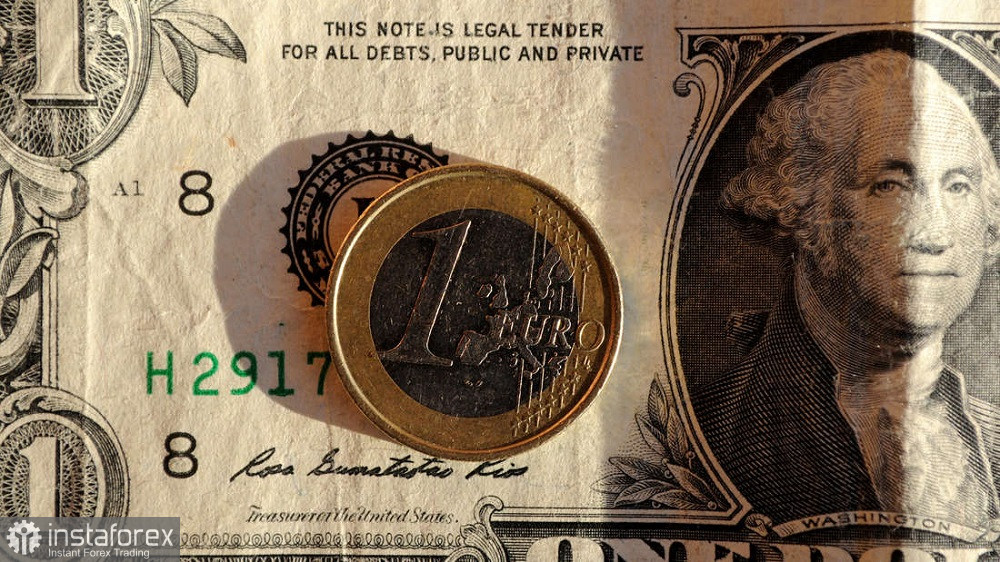The euro/dollar pair is still trading within the 9th figure, although yesterday, sellers of EUR/USD tried to secure a position below the 1.0900 target. This attempt was unsuccessful: bears rushed to lock in profits, after which buyers of the pair took over. However, they also cannot boast of any tangible achievements. For a situation shift, they need to overcome the resistance level of 1.1020 (the middle line of the Bollinger Bands indicator on the daily chart), while they can't even break through the transient price barrier of 1.0970 (the Tenkan-sen line on the same timeframe). The pair is dominated by bearish sentiment, but the bears need additional fundamental arguments to, first, establish themselves within the 8th figure and, secondly, attract "doubting" market participants who lock in their profits when falling below the 1.0900 mark.
ZEW Indices
Today, the German indices from the ZEW Institute provided some support to the European currency, coming out in the "green zone," although they did not reflect an improvement in sentiment in the European business environment.

For instance, the German business sentiment index remained in negative territory, settling at -12.3 points. According to the forecasts of most experts, the indicator was expected to drop to -15 points. The economic sentiment index for the Eurozone as a whole also remained below zero. However, while the forecast was a drop to -12 points, the indicator turned out to be at -5 points. The "green tint" of the release provided a little support for EUR/USD buyers, although de facto there is no optimism to speak of here. In this case, traders used this report as a reason for a corrective pullback following yesterday's decline to the 1.0876 mark (5-week price low).
Retail Sales and Empire Manufacturing Index
The block of macroeconomic statistics published today in the US turned out to be quite contradictory.
On the greenback side, there was the retail sales indicator. The volume of retail trade in the States grew by 0.7% in July – this is the best result since January of last year. Excluding car sales, the indicator also came out in the "green zone," reflecting an increase of 1.0% (the best result in the last seven months). The report's structure also indicates that retail sales outside stores grew by 10% compared to last year, and public catering services and drinking establishments increased by 11.9% compared to July of last year.
This strong result did not help the greenback because the Empire Manufacturing Production Index disappointed dollar bulls. As is known, this indicator is based on a survey of manufacturers in the New York Fed's district – a value above zero reflects an increase in activity; below – its decline. Instead of the expected decline to the -0.9 point mark, the index plummeted to -19 points in August (after rising to 1.1 in July).
These conflicting macroeconomic signals were interpreted against the US currency.
Riding the waves of a broad-range flat
Relatively decent ZEW indices (although here the term "non-catastrophic" is more appropriate) and contradictory US releases helped EUR/USD buyers return to the 9th figure area, i.e., the price range in which the pair has been trading for the last two weeks. True, last week buyers were still making short-term bursts into the 10th figure area, while this week the situation has a mirror character – sellers are making "raids" into the 8th figure area. However, this does not change the essence: EUR/USD buyers cannot consolidate above 1.1000, sellers – below 1.0900. The 9th figure area is a comfortable price zone for both sides of the confrontation, a kind of "neutral territory."
Considering the prevailing fundamental background, it can be assumed that the current growth of the EUR/USD pair is corrective. The "ceiling" of the corrective pullback is at 1.0970 – this is the Tenkan-sen line on the D1 timeframe.
It is important to remember that on the greenback's side are not only the retail sales report but also the report on the import price index growth. According to data published today, the index came out in the "green zone": every month, for the first time since April this year, it was above zero.
Moreover, anti-risk sentiments are growing in the market, which may also support the safe-haven dollar.
First, market participants were once again disappointed by Chinese macroeconomic reports. After disappointing data in the field of foreign trade, China published data on the volume of retail sales and industrial production. All components of the reports were in the "red zone."
Second, the market was alarmed by information that the rating agency Fitch Ratings may lower the ratings of several major creditors (specifically, JPMorgan). Fitch analysts stated that the US banking sector "is approaching instability."
It should be noted that this rating agency previously downgraded the long-term issuer default rating of the US from "AAA" to "AA+." Among the reasons for this decision were a deterioration in budgetary indicators and an increase in the national debt. The greenback then strengthened across the board amidst rising anti-risk sentiment.
Thus, considering the contradictory fundamental picture for the EUR/USD pair, going long is currently risky. On the other hand, short positions seem quite attractive as the northern impulse fades. The resistance level is the aforementioned target of 1.0960 (Tenkan-sen line on D1). Support levels (targets for the southward movement) are 1.0900 (the lower line of the Kumo cloud on the daily chart) and 1.0860 (the lower line of the Bollinger Bands indicator on the same timeframe).
 English
English 
 Русский
Русский Bahasa Indonesia
Bahasa Indonesia Bahasa Malay
Bahasa Malay ไทย
ไทย Español
Español Deutsch
Deutsch Български
Български Français
Français Tiếng Việt
Tiếng Việt 中文
中文 বাংলা
বাংলা हिन्दी
हिन्दी Čeština
Čeština Українська
Українська Română
Română

